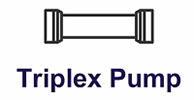What Are Piston and Plunger Pumps?
A piston pump is a positive displacement pump where fluid movement is created by a piston. There are 3 types of such designs which are: piston, plunger, and rotary piston pump.
 What are The Types of Piston Pumps, and How Do They Work?
What are The Types of Piston Pumps, and How Do They Work?
There are 3 types of piston pumps:
Rotary Piston
Rotary piston pumps work by a piston sliding back and forth along a rotors groove drawing liquid into the inlet. Two directly driven pistons move reciprocally in cylinders, with the piston drawing back towards the centre of the pump when at the pump inlet causing fluid to be drawn into the inlet. As the rotor moves towards the outlet of the pump the piston moves along the rotor expelling liquid via the outlet.
Piston Pumps
A piston pump operates by a piston pushing a seal back-and-forth within a chamber, which creates vacuum and pressure. The seal is disc shaped, and fluid is driven through the hollow cylinder known as a piston, manufactured from ceramic.
Piston pumps can have anywhere between a single piston, or multiple pistons, timed to operate at differing intervals to create an even level of flow. Piston pumps are often known as 3, 5 or 7 frame pumps which denotes the number of pistons present within the pump head.
Plunger Pumps
Plunger pumps are pumps in which a plunger slides back and forth within a stuffing box, increasing and decreasing the working volume. Such designs are better suited for high pressures as seals are stationary within the pump, as opposed to piston designs where the seal slides within a hollow chamber.
Differences Between Piston and Plunger Pumps
Below is a table outlining the differences between piston and plunger pumps:
| Piston Pumps | Plunger Pumps |
| High-pressure seal reciprocates with the piston in the cylinder. | High-pressure seal is stationary. Plunger slides through seal allowing the pump to be used at higher pressures. |
| Inlet design pressure of 8.5psi to 40psi (0.58 bar to 2.8 bar). | Inlet design pressure of 60-70psi (4-5 bar). |
| Best suited to short duty cycles unless a larger pump operates slowly. | Okay for continuous operation when ran slowly. |
| Inlet values are mechanically actuated. | Requires flooded suction or higher inlet pressure supplied by a booster pump. |
| Output pressure 100-1200psi (6.9 bar to 83 bar). | Output pressure 100 to 10,000psi (6.9 bar to 700 bar). |
| View working animation for a piston pump | View working animation for a plunger pump |
How Efficient are Piston Pumps?
Piston pumps have one of the highest efficiencies available being 85-90% efficient. They can be directly driven by motors or driven via V belts protected by guards eliminating the requirement for a gearbox which can often add to transmission losses.
What are Piston Pumps Used For?
Typical applications for piston and plunger pumps are where a low flow rate of a liquid is required at high pressure within an application, such as Seawater through a filter for reverse osmosis, or chemical injection where pipework is pressurised and a high-pressure pump is required to overcome existing line pressure.
As piston pump designs are positive displacement, with the volume dispensed being proportionate to speed it means they are predictable for the transfer of liquids in batching and metering applications.
Such designs are limited to those handling liquids which are clean, free from solid or abrasive particles which would otherwise cause internal seals to perish, internal parts to clog and not seal or suffer from abrasion reducing the lifespan of units.
Liquids such as Fuels, chemicals and seawater can be handled with such designs, however pumps generally require a flooded suction, or in high flow units a booster pump and are not always suited for applications where a self-priming pump is required.
Some the most common applications include:
Chemical injection
Descaling of heat exchangers or boiler tubes.
Drill cutting injection
Fuel transfer
Gas dehrydration using monoethylene glycol (MEG) or triethylene glycol (TEG)
Hydro excavation and hydro blasting
Hydrostatic and pressure testing of equipment
Jetting, cleaning and washdown of plant equipment such as conveyors, bottles, kegs, pallets, and other process equipment as pressure washers
Misting of fluids via nozzles, fogging for fire control, and mist odour control
Reverse osmosis to create fresh water from sea water
Seal flush feed pump to ensure seals on another pump remain free from abrasive particles and clean
Spray bar feed for the coating of products with fats, polymers or other coatings
Surface treatment: hull cleaning, removal of concrete from pipes or rebar as well as label, graffiti, paint, and rust removal.
Produced Water Reinjection
Advantages and Disadvantages of Piston Pumps
Advantages
Their pressure generating capability is unmatched by other designs.
Due to their high efficiency, substantial savings can be made against other designs of high-pressure pumps such as pitot tube pumps.
As designs are positive displacement, with fluid flow proportional to speed, they are predictable in nature for transfer and injection applications.
Designs are available which are self-priming with high suction capabilities as well as those which can accommodate viscous liquids.
Smaller designs which are directly driven by motors are unmatched in pressure generating capability
Disadvantages
They are not suited for some applications as they produce a pulsating flow, which can be addressed to some extent by the utilisation of a pulsation dampener.
Piston pumps require a larger investment and can be an expensive way to transfer liquids. As they are limited to clean liquids there are many other designs of pump to rule out first which are far more economical as well as easier to maintain.
Parts can be expensive due to their high precision and compact nature. Units are time consuming to maintain with some designs having a high quantity of internal parts making troubleshooting difficult, time consuming and which can lead to the replacement of many internal parts before the root cause of an issue is known. Maintenance is often required by experienced personnel.
Additional accessories may be required to get the most from the pump such as a pressure regulating valve, relief valve and pulsation dampener further complicating pump set up requirements.
Installed units can take up large amounts of space especially when driven via V belts, as units are then bulky in nature with motors situated alongside the pump head, instead of inline as is common with other designs.
High flow designs can require a separate booster pump to feed the unit and ensure cavitation does not occur.
Piston pump P&ID symbol
Further Guidance
If you have an application with a high-pressure, low flow requirement then a piston pump may be worth considering for your process.
To discuss your application with a technical sales engineer, contact us to see how we can help.
FAQS
These additives provide further lubrication to the crankcase that is not provided by standard oils. We can supply this oil in various container sizes. Using alternative oil may lead to more frequent oil changes being required and premature wear of the crankcase components.
Pulsation dampeners or accumulators have additional benefits like reducing vibrations in pipework and extending the life of components downstream from the pump, such as regulating valves. By reducing pulsations and vibrations, the risk of water hammer is significantly reduced, and operators experience less fatigue when using hand operated nozzles.
A regulating valve is the primary protection for the pump and operator, this regulates pressure to the required amount for the system. The unloader valve relieves pressure and protects the pump and the operator during nozzle applications.
The unloader valve will open and relieve the excess pressure when the nozzle is closed. A further relief valve should be installed as a last line of defence in case the regulator/unloader valve fail to operate. The relief valve is typically set around 200-300 PSI above the unloader/regulator set pressure.






